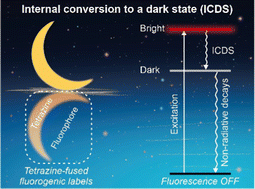The fluorescence quenching mechanism of tetrazine-functionalized fluorogenic labels with integrated π-conjugations: internal conversion to a dark state†
Abstract
Tetrazine-based fluorogenic labels have been extensively applied to the studies of living systems due to their excellent selectivity, rapid reaction kinetics, and unique fluorogenicity. However, the fluorescence quenching mechanism in many precursor dyes remains controversial, impeding rational molecular engineering to optimize their fluorescence enhancement ratios. Herein, employing quantum chemical calculations, we established a quenching mechanism – internal conversion to a dark state (ICDS), to rationalize the fluorogenicity in tetrazine-functionalized labels with integrated π-conjugations. We show that the ICDS efficiency is negatively correlated with the energy gap between these labels’ first excited state (the dark state) and the second excited state (the bright state). Based on this correlation, we further proposed molecular design strategies for developing biocompatible long-wavelength fluorophores with improved fluorogenicity.

- This article is part of the themed collection: Materials Chemistry Frontiers Emerging Investigator Series 2022–2023


 Please wait while we load your content...
Please wait while we load your content...